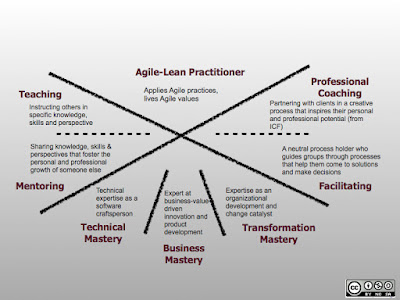Foster Autonomy: Teach and support the team and individuals to be autonomous within the given boundaries of the organization and its processes.
Create Ground for Motivation: Help teams to maximize their autonomy, individual mastery and make sure the team has a purpose.
Provide Coaching: Support teams and individuals to identify potentials with their roles and within the agile organization and improve.
How Can You Do It?
Lateral Leadership: Mediating the team through conflicts and help them with making decisions and foster the team's self-organization. After a few months a team shall have jelled.Facilitation: Facilitate meetings for the team, including preparing, moderation and post processing for the agile process as well as the supporting agile organization. After a year of working with a team, the team members shall be empowered to run regularly all events without you attending.
Teaching: Teach teams agile practices and lateral leadership. A central area is technical excellence and software craftsmanship. Long lasting teaching shall concentrate on values: Scrum values, Scrum principles, Less principles, Agile manifesto and the associated 12 principles.
Impediments: Actively identify impediments and foster their removal. Consult the Scrum guide: You must select one impediment after each retrospective and add it as high priority item in the next Sprint backlog. This mechanism insure continuous improvement.
To ensure continuous improvement, it includes at least one high priority way in which the team works, identified in the previous Retrospective meeting.Culture: Establish a culture of inspect and adapt for teams , create structure to establish a continuous improvement process - also meaning establish a tolerance to failure -, advocate for transparency, enlighten the organization of the relation between autonomy and accountability.
Ask yourself how your organisation handles meritocracy.
One Approach to Coaching
Agile teams thrive with purpose, autonomy and mastery. One approach to coaching is to set your focus on
- Understand the domain: Talk with customers and users and understand their needs. Your teams should have business expertise,
- Master Technical Excellence: CI, CD, TDD, ATDD, pair programming, refactoring, lean UX, usability
- Use Process Excellence and apply Scrum, XP, LeSS by the book:
- Discuss the core values of commitment, focus, openness, respect, and courage,
- Present again the agile manifesto and the twelve principles
- Show the organization why commitment in the planning was replaced by forecast in the official Scrum guide,
- Require a vision, a roadmap, a release plan with a story map and a refined backlog for each product and team,
- Tell why an impediment resolution backlog item shall be part of each iteration,
- Teach the importance of Definition of Done for the internal quality of the product. And explain why Definition of Ready is often an anti-pattern,
- Show why velocity is not a productivity metrics,
- Show the difference between outcome and output,
- Extend the agile toolbox with Design Thinking, Lean Factory, Lean UX, DevOps,
- Pair Scrum master and technical master to implement a craftsmanship path and achieve product quality,
- Explore Center of Competencies to nurture your product development group,
Once you are a master fell free to break the rules, experiment with new rules, approaches. Define hypotheses and verify them empirically.
If you are coaching software development groups acknowledge you shall possess profound understanding of technical excellence and software development practices. I never heard of a soccer coach not intimately knowing how the game is played.
If you are coaching software development groups acknowledge you shall possess profound understanding of technical excellence and software development practices. I never heard of a soccer coach not intimately knowing how the game is played.

No comments:
Post a Comment